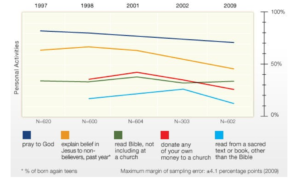By Eddie Pipkin
September 22, 2017
I love conversations with 20-somethings. They can be inspiring, eye-opening, hopeful, and—on occasion—a stinging reminder of how we as ministry leaders have blown it. Take, for instance, the fundamental spiritual discipline of generosity (phrase it as the biblically accurate “extravagant generosity,” if you like, or the more high-toned “stewardship,” but, however you phrase it, I’m talking about the practice as followers of Jesus of routinely sharing the best of who we are and what we have to support God’s work). This particular 20-something, one of my favorites—bright, adventurous, joyful, curious, with an outsized heart and a big faith to match—has a great job, and he was regaling me with his laser-focused plan for saving and investing as much of his current income as possible. It was a bold strategy for a young person. He detailed stock purchases, mutual fund investments, maxing out his 401(k). It was complex and disciplined, and included all the ways he was cutting costs and micro-managing day-to-day expenses to fund his “retire at 40 and travel the world” goal. But knowing how important his faith is to him, I stopped him after a couple of minutes and said, “Wait a minute. That is amazing—I wish I had had that much sense when I was your age, but I haven’t heard you mention anything about giving.”
“What do you mean?” he said.
“You know, giving,” I said. “Giving back, giving to God, supporting the Kingdom work, one of the primary spiritual disciplines of those who follow Jesus . . . stewardship, tithing . . . you know, all that.”
supporting the Kingdom work, one of the primary spiritual disciplines of those who follow Jesus . . . stewardship, tithing . . . you know, all that.”
“Yeah, that’s not really a thing at this point.”
Now, this is a young man who is serious and thoughtful about his faith, who grew up in the church, was deeply involved in his youth group and later served as one of the assistant leaders of that group. In fact, he has recently been tapped to provide some important temporary ministry leadership to a youth group in transition. But he expressed a disconnect with the whole Old Testament “tithe to earn your way into heaven,” guilt-folks-into-giving vibe, and he was totally turned off by the whole prosperity gospel movement. He has also been around individual congregations enough to see the sausage getting made and so, like many in his generation, is deeply skeptical about what happens to what ends up in the offering plate. He was much more comfortable sending some money to a Go Fund Me account for a friend embarking on an international mission trip (which as a naturally generous person, was the kind of appeal to which he would occasionally respond).
But giving as a discipline, as a rich, soul-affirming, firstfruits, “God owns everything and I’m just taking care of it” organized kind of strategy . . . not so much a thing.
“Wow,” I said, experiencing a sober epiphany. “I am sorry. You have been part of youth groups and churches where I was a leader. And we failed you. On this point—and it’s a really important point—we totally failed you.”
I do a lot of thinking and writing about why churches are struggling, and here, right in front of me, was a glaring reminder of how we as ministry leaders miss opportunities to teach about biblical generosity. We miss opportunities in our worship gatherings to focus on the power of faith-based generosity, and we miss opportunities to build a sense of stewardship in our children’s ministries and youth groups. Don’t believe me? How about a chart from Barna? This graphic shows the changes in spiritual habits by teenagers over a decade, and the red line is the “donate any of your own money to a church” category. While we have often done a great job in building children’s and youth ministries which impart a strong sense of inclusion and family, we haven’t always been as diligent in exploring the full range of spiritual disciplines (maybe the whole “discipline” thing has been a turnoff that has kept us from aspiring to the richly rewarding work of practical faith). We certainly can’t expect children and youth who grow up in our spiritual care to suddenly, miraculously develop habits as adults that we failed to teach them when we had the chance.
This graphic shows the changes in spiritual habits by teenagers over a decade, and the red line is the “donate any of your own money to a church” category. While we have often done a great job in building children’s and youth ministries which impart a strong sense of inclusion and family, we haven’t always been as diligent in exploring the full range of spiritual disciplines (maybe the whole “discipline” thing has been a turnoff that has kept us from aspiring to the richly rewarding work of practical faith). We certainly can’t expect children and youth who grow up in our spiritual care to suddenly, miraculously develop habits as adults that we failed to teach them when we had the chance.
Here are some observations.
- We should have a 52-weeks-a-year strategy in place for teaching generosity and stewardship to our congregations. Since it is an integral part of discipleship, it should be an integral and organic part of our worship services, our spiritual growth opportunities, and our communications (the ongoing narrative of who we are). As Nan Duerling writes in Ministry Matters (in an article with some great insights about teaching stewardship):
While stewardship does include how we get, spend, and give our money, this narrow definition of stewardship as church fundraising falls far short of the rich, comprehensive understanding of stewardship that we find in the Bible. Stewardship is not a particular activity such as serving on a committee or making a financial pledge. Rather, stewardship is a way of life that requires us to put God first in all things, trust God to meet our needs, and be accountable to God in the way that we use all of the resources entrusted to our keeping. If we use these resources as God intends, the earth and all who dwell in it will be cared for.
- Our strategy for teaching generosity and stewardship should include presenting hands-on opportunities to experience these concepts for youth groups and children’s ministries. Children, who are aggressively marketed to in our culture, are forming basic concepts about their relationships to stuff. Teenagers are in the beginning stages of earning their own money and making their own choices about how they will use the precious resources of their time and talents. (Here are some ideas from the Canadian Anglicans for youth groups, and here are some for kids’ ministries from Focus on the Family.)
- Powerful discussion can happen when we draw groups out of their respective silos and bring them together for discussions on topics of generosity and stewardship. (Here is a great series of lesson ideas for intergenerational groups working together.)
- We should have a ready list of resources available when individuals or small groups ask for help in understanding the concepts of generosity and stewardship. (Adam Hamilton’s Enough is a popular and easily accessible resource of recent years.)
- It is very important to creatively communicate stories about the impacts of generosity. Beyond the Bible studies and theological explorations of these challenging concepts, the greatest visceral impact remains sharing person-to-person stories of how giving changes lives (for givers and recipients). Don’t miss opportunities to share these stories in words, pictures, video, and on social media platforms. Younger generations are focused on wanting to be confident that their generosity is having a real-world impact, which is why they are more likely to support individual causes than generic church funds. (We can take a lesson from charities that have a robust strategy for communicating donor impact, like Heifer International, Habitat for Humanity, and one of my personal favorites, the small but compelling charity, 88bikes.)
One of the resources we have recently developed at Excellence in Ministry Coaching is called Discipler. It’s a biblically-based guide for small groups to work together through daily activities and weekly discussions to explore six dimensions of discipleship, including a focus on generosity (this resource is currently available as electronic download, but will be available as a paperback later this fall—you can check out an excerpt at the link above).
What is your congregation currently doing to develop a deeper understanding of generosity and stewardship? What are your thoughts on this topic, specifically regarding young people and their perspectives related to issues like giving and serving. We love to hear from you.







Leave A Comment